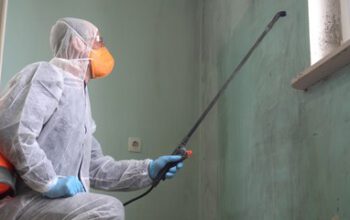
Mold spores can thrive in porous materials like wood, drywall, and paper. These spores grow when they have consistent moisture and an organic food source. Professional Mold Remediation clean these materials, then spray them with biocide to prevent spores from reproducing. Reduced marker fungi in bulk samples of cleaned materials indicate successful remediation.
Water damage can occur from a burst pipe, severe storm, or fire. A quick response is vital when these events happen to mitigate the damage and prevent mold growth.
Mold is a fungus that creates tiny spores which spread and thrive in moist environments. They cause a musty, damp odor and are often found in dark areas like behind drywall, in basements or in doorways. Mold spores can also be toxic to humans, especially those who have existing health problems such as asthma.
The first step in preventing mold from growing after water damage is to clean up the affected area. The best way to do this is to call in a professional. They will come and remove the contaminated materials, and they will also dry out the area to prevent additional damage. In addition, they will address the issues that caused the water damage in the first place.
During the cleanup process there are some things that homeowners can do to help speed up the drying process and minimize the risk of mold. For example, it is important to turn off all air conditioning and heating systems as they can make the drying process more difficult. In addition, it is a good idea to keep the temperature in the home moderate as high temperatures can promote mold growth.
Once the contaminated materials have been removed it is a good idea to disinfect the area. This can be done by using a bleach solution of one cup of household laundry bleach per gallon of water. In addition, it is important to use a respirator and goggles when using any cleaning products. It is also important to replace any porous materials that have been contaminated by mold with new, mold resistant materials.
Mold spores can live dormant or inactive in the surface of hard surfaces such as cement, glass or metal. However, if the spores are allowed to re-enter the environment or come into contact with moisture they will grow again. Depending on the type of mold, this can lead to more serious health problems.
Mold Growth
Mold growth occurs anywhere there is a water problem and moisture. Mold spores are always present in the air and will settle on any damp surface, starting to grow once they have a food source. Once the mold starts growing, it will eat away at whatever it is growing on in order to survive. This can cause the drywall and framing in your home to decay. This is a serious structural problem that can cost you a lot of money to repair and also creates a safety risk for your family.
Fortunately, contents restoration technologies have advanced to the point where many items that were once considered ruined can now be saved. Near the beginning of the remediation process, a contents pack out will occur, where a restoration company removes all saveable items such as textiles, hard goods, photos, and more to be cleaned and restored off site. This includes things like drapes, furniture, carpeting, etc. This process helps to speed up the restoration process and prevents the need to clean items twice.
When a mold growth is detected, it will be evaluated and a mold remediation plan developed. This will typically include a thorough inspection and testing of the affected area to determine the extent of the mold growth and identify the cause of the mold. This is followed by cleaning, sanitizing and disinfecting the contaminated areas. This is then followed by drying all wet materials and some experts may even use dehumidifiers to help speed up this process.
It is impossible to eliminate all types of mold because it is a natural part of our environment and is inherent in outdoor environments as well. It is possible, however, to minimize the mold growth by quickly identifying and fixing any issues that caused it to grow, including repairing any leaks and replacing any rotting building material.
Mold can be a very dangerous problem when left unattended, especially in homes with young children and elderly people. It can also be a health hazard for those who suffer from allergies or asthma as some types of mold produce potent allergens and irritants.
Symptoms
Mold growth indicates a problem with water infiltration and often results in structural damage. The presence of mold also poses a serious health risk for building occupants. It’s important to remove mold quickly and clean any affected items. This will help reduce the spread of mycotoxins and other toxins produced by the mold.
Mycotoxins are dangerous to humans and animals. They can cause a wide range of symptoms, including fatigue and headaches. They can also irritate the nose, throat and eyes. The severity of a person’s reaction to mycotoxins depends on their sensitivity, other health conditions, the type and duration of exposure and how much mycotoxin is present in the environment.
People who are sensitive to mold have a more immediate and more severe reaction. These symptoms can include skin rashes and irritation; coughing, sneezing or other respiratory problems; eye infections or dry itchy, stinging skin; and asthma attacks. In some cases, the fungus that produces the mycotoxins can even enter the bloodstream and cause systemic fungal infection.
Many of the same symptoms can be caused by other organisms, but a physician should always be consulted to make sure that the health issues are related to mold and not another pathogen. Some molds produce mycotoxins that can cause gastrointestinal symptoms such as nausea and vomiting.
Some health professionals are hesitant to recommend immunotherapy as a treatment for allergies to mold, but this therapy is effective in the long term and has been proven safe and effective for some individuals. This treatment involves a series of allergy shots over the course of several years.
The best way to prevent mold is to monitor the humidity in your home. Humid environments encourage the growth of various molds. Use a dehumidifier during summer and thoroughly ventilate rooms in the home, especially kitchens and bathrooms. In addition, check for leaks regularly and fix them promptly. If your home experiences extensive water damage, the affected areas should be cleaned and dried within 48 hours to minimize mold growth. Avoid using drywall and other porous materials that can support mold growth, and take any soft items that have been damaged by water or moisture to a restoration specialist for proper cleaning and disposal.
Prevention
Mold spores are present in the air, and they can cause reactions in those with sensitive immune systems. But they only pose a health threat when damp organic material that provides food for them is present in your property and is kept damp for long periods of time. It is therefore imperative to prevent the conditions that allow mold to thrive in your home. This can be done by addressing humidity levels and repairing leaks as quickly as possible and cleaning regularly.
Mold and mildew grow on a wide variety of surfaces, including paper products, cardboard, fabric, wood and other natural materials, some foods, plants, and ceiling tiles. When they become damp, they produce spores that spread through the air and can break down or destroy whatever they are growing on. If you notice any damp or dark spots on walls or in rugs, act fast to correct the problem before it gets out of hand.
If you discover a large area of mold growth, it may be necessary to hire professional mold remediation services. These specialists have the tools and experience to address a complex situation. Depending on the extent of the mold infestation, they may need to tear down walls, carpeting, and other materials that have been contaminated with the fungus. In addition, they can test for and remove spores from the air and ductwork. The professionals can also advise you about mold prevention strategies, and recommend products that will discourage future growth, such as a mold inhibitor for paints.
To prevent mold, check areas where condensation and moisture buildup can occur regularly, such as the corner of a basement or bathroom, windows and sills, and kitchen and bath areas. Keep these areas clean, dry and free of clutter to limit the buildup of organic material that can provide a home for mold spores. Regular cleaning of nonporous surfaces such as drywall, paints, and fabrics can help reduce the amount of mold that develops in a home. Always follow the instructions for cleaning materials provided by the manufacturer.
Keeping indoor humidity below 60 percent is essential to preventing mold, as is repairing water damage in a timely manner. It is also important to encourage ventilation in the bathroom, kitchen, laundry room and other high-moisture areas; to use air conditioners and dehumidifiers in the summer and winter, as appropriate for the climate where you live; and to open windows and run exhaust fans when cooking, dishwashing or showering.

